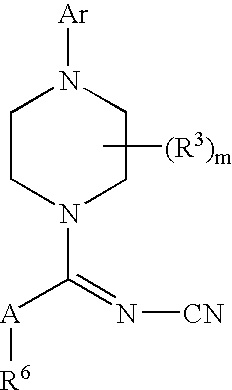Therapeutic agents useful for treating pain
- Summary
- Abstract
- Description
- Claims
- Application Information
AI Technical Summary
Benefits of technology
Problems solved by technology
Method used
Image
Examples
example 1
5.1. Example 1
Synthesis of Compound AAA
[1062] 103
[1063] 2,3-Dichloropyridine (15.0 g, 101.6 mmol), piperazine(9.78 g, 113.70 mmol), and triethylamine (14.36 g, 141.95 mmol) were dissolved in 300 mL of DMSO and the resulting mixture was heated at about 80.degree. C. for about 24 h. The reaction mixture was then cooled to room temperature and extracted with a saturated aqueous sodium bicarbonate solution. The organic layer was dried, concentrated, and purified using a silica gel column eluted with a gradient elution from ethyl acetate to 2:1 ethyl acetate:methanol to provide N(3-chloropyridin-2-yl)-piperazine (compound 1) as a yellow liquid.
[1064] A solution diphenylcyanocarbodimidate (Commercially available from Sigma-Aldrich, St. Louis, Mo. (www.sigma-aldrich.com)) (0.5 mmol) and 4-tert-butylaniline (0.5 mmol) in 1.5 mL of DCM was stirred at room temperature for about 12 h. The mixture was concentrated under reduced pressure to provide compound 2, which was used directly in the next...
example 2
5.2. Example 2
Synthesis of Compound AAI
[1068] Compound AAI was prepared by a procedure analogous to that used to prepare Compound AAA except that 4-trifluoromethoxyaniline was used in place of 4-tertbutylaniline (yield 78%).
[1069] The identity of compound AAI was confirmed using .sup.1H NMR.
[1070] Compound AAI: .sup.1H NMR (CDCl.sub.3) .delta. 8.19(dd, J=1.6, 4.7 Hz, 1H), 7.62 (dd, J=1.6, 7.8 Hz, 1H), 7.26 (b, 1H), 7.24 (d, J=9.0 Hz, 2H), 7.12 (d, J=9.0 Hz, 2H), 6.92 (dd, J=4.7 Hz, 1H), 3.59 (m, 4H), 3.35 (m, 4H) ppm.
example 3
5.3. Example 3
Synthesis of Compound AAG
[1071] Compound AAG was prepared by a procedure analogous to that used to prepare Compound AAA except that 4-trifluoromethylaniline was used in place of 4-tertbutylaniline (yield 61%).
[1072] The identity of compound AAG was confirmed using .sup.1H NMR.
[1073] Compound AAG: .sup.1H NMR (CDCl.sub.3) .delta. 8.19(dd, J=1.6, 4.7 Hz, 1H), 7.62 (dd, J=1.6, 7.8 Hz, 1H), 7.26 (b, 1H), 7.24 (d, J=9.0 Hz, 2H), 7.12 (d, J=9.0 Hz, 2H), 6.92 (dd, J=4.7 Hz, 1H), 3.59 (m, 4H), 3.35 (m, 4H) ppm. 5.4. Example 4: Synthesis of Compound DEY 104
[1074] To a solution of 2-(1-cyclohexenyl)-ethylamine 3 (125.2 mg, 1.0 mmol) in 2-methoxyethyl ether (2.0 mL) was added diphenylcyanocarbodimida-te (commercially available from Sigma-Aldrich, St. Louis, Mo. (www.sigma-aldrich.com)) (238.2 mg, 1.0 mmol) at room temperature. The resultant reaction mixture was heated to about 80.degree. C. and allowed to stir at 80.degree. C. for about 5 h. (R)-1-(3-chloro-pyridin-2-yl)-3-m-ethy...
PUM
| Property | Measurement | Unit |
|---|---|---|
| Fraction | aaaaa | aaaaa |
| Pharmaceutically acceptable | aaaaa | aaaaa |
Abstract
Description
Claims
Application Information
 Login to View More
Login to View More - R&D
- Intellectual Property
- Life Sciences
- Materials
- Tech Scout
- Unparalleled Data Quality
- Higher Quality Content
- 60% Fewer Hallucinations
Browse by: Latest US Patents, China's latest patents, Technical Efficacy Thesaurus, Application Domain, Technology Topic, Popular Technical Reports.
© 2025 PatSnap. All rights reserved.Legal|Privacy policy|Modern Slavery Act Transparency Statement|Sitemap|About US| Contact US: help@patsnap.com



